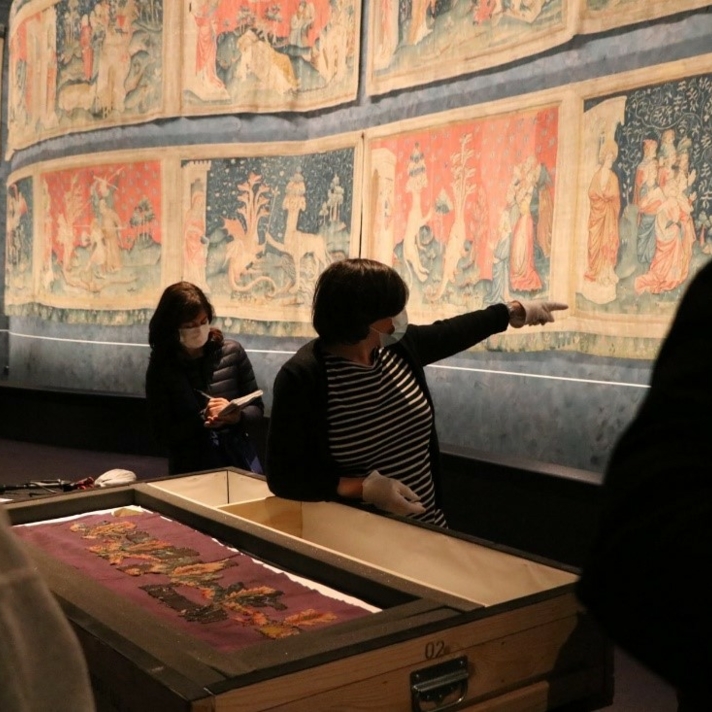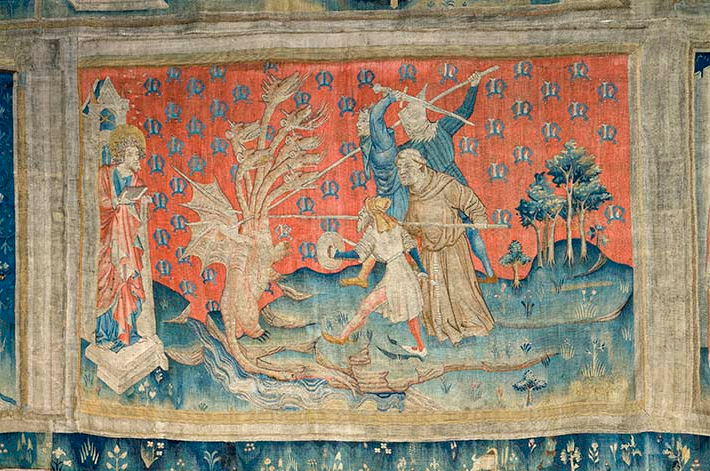Nun, Scientist, Artist, Saint: Meet Hildegard von Bingen
Saint Hildegard von Bingen (1098-1179), also known as the Sybil of the Rhine, is one of the most renowned figures from the European Middle Ages. She...
Iolanda Munck 18 July 2024
Tapestry, a delicate medium, is perfect for an elusive apocalypse narrative. This narrative becomes substantiated through the Book of Revelation, in the final story written by John. One of the most discussed books in the Bible for its enigmatic imagery, it nevertheless became subject to an artistic intervention during the 14th century, when a patron commissioned the story to be made into a beautiful tapestry set known as The Apocalypse Tapestry, considering it a fitting representation of their time.

Jean Bondol and Nicholas Bataille, The Apocalypse Tapestry, “The Tears of Saint John,” 1377-1382, Château d’Angers, Angers, France. Detail. Antoine Ruais / Centre des monuments nationaux.
Commissioned by Louis I of Anjou in 1373, The Apocalypse Tapestry depicted the time of the Hundred Years’ War and the Black Death. It represented a time when Europe was failing, and the world might have very well ended. Therefore, when illustrator Jean Bondol took the commission, it became a fragile work of art, both figuratively and literally.
Interestingly, Bondol used an illuminated manuscript as his model. It was later woven in Paris, which was the leading tapestry center in Europe at that time and favored by Louis. It is now on view at the Château d’Angers in the Loire Valley, France.

Jean Bondol and Nicholas Bataille, The Apocalypse Tapestry, “The Myriads of Horsemen,” 1377-1382, Château d’Angers, Angers, France. Isabelle Guegan / DRAC des Pays de La Loire.
The Apocalypse Tapestry is notably huge, surpassing the dimensions of an entire room upon completion. It comprises six sections, each stretching an impressive 78 feet in width and 20 feet in height. Housing a total of 90 distinct scenes, the tapestry, unfortunately, witnessed the loss of 19 scenes, leaving only 71 extant today. The artwork vividly portrays mythical creatures like dragons, seamlessly blending them with contemporary elements of the Middle Ages, featuring knights, monks, diverse costumes, and musical instruments.
Throughout the 14th century, when the tapestry graced events like weddings or diplomatic festivals, organizers found it convenient to arrange them by color, based on the alternating red and blue backgrounds of each tapestry section. Although the vibrant hues have faded with time, the tapestry’s original brilliance was a spectrum of blue, green, orange, and ivory threads.

Image of The Apocalypse Tapestry fragments returning to the château in 2021. Emma Fonteneau / Domaine national du château d’Angers.
At its completion, the tapestry originally had accompanying text woven at the bottom of each panel to help explain the scene. Of course, those texts no longer survive. Luckily, the tapestry’s story is very well known: the battle of Good versus Evil from the Bible. In the simplest terms, the Book of Revelation has three sections: the epistolary, the apocalyptic, and the prophetic. The narrative reveals John’s vision or prophecy as he has seen it. While the genre of the story is apocalyptic, John only portrays himself as a Christian prophet warning the world of what is to come. In the tapestry, his vision is rendered according to the patron’s ambitions.

Jean Bondol and Nicholas Bataille, The Apocalypse Tapestry, “The dragon fights the servants of God,” 1377-1382, Château d’Angers, Angers, France. Caroline Rose / Centre des monuments nationaux.
For example, in the scene above, “The dragon fights the servants of God,” Louis I portrays himself as the leader of his society fighting against Evil. He does this by implementing his L and M monogram as a pattern in the background. But unlike John’s religious message in the Book of Revelation, Louis I uses the tapestry to send a political one; Europe was in the midst of the Hundred Years’ War at the time of the tapestry’s creation.
This type of political display was typical during the Middle Ages and continued into the Renaissance. For instance, Catherine de’ Medici also commissioned a set of tapestries to signify her political strengths during the 16th century.
DailyArt Magazine needs your support. Every contribution, however big or small, is very valuable for our future. Thanks to it, we will be able to sustain and grow the Magazine. Thank you for your help!